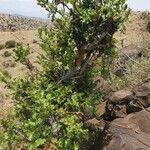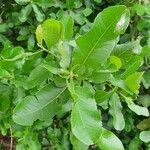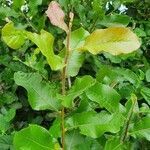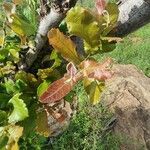Tree up to 10 m tall with spreading crown; branchlets tomentellous, glabrescent. Leaves petiolate; petiole up to 15 mm long, tomentellous; lamina up to 10 x 6 cm, oblong to narrowly oblong, chartaceous to subcoriaceous, shortly pubescent above especially on the nerves, tomentellous beneath, apex rounded and usually shortly mucronate, margin entire to sharply serrate, base rounded to subcordate; lateral nerves 10-20 pairs, branching near the margin. Inflorescence up to 16 cm long; rhachis tomentellous. Flowers yellowish or greenish, in fascicles or subsessile cymules on the rhachis; pedicels up to 4 mm long. Sepals 1.3 mm long, connate to above the middle. Petals 0.7-1 mm in diam., subcircular, unguiculate. Disk 2 mm in diam. Stamens 8-10 (reduced in size in [female] flowers); filaments up to 3 mm long; anthers 1 mm long. Ovary 3-gonous, tomentellous; style up to 5 mm, appressed-pubescent. Fruit (usually reduced to 1 coccus) c. 10 mm in diam., subglobose, tomentellous. Seed black, shiny, c. 7 mm in diam., subglobose, nearly surrounded by the arillode.
A tree. It grows 3-9 m high. It grows taller in moist regions and is smaller in arid places. The leaves are towards the ends of twigs. The leaves are stiff, rough and simple. They can be 2.5-4 cm long and 8 mm wide in arid places and 3 times that size in most places. The base can be rounded or heart-shaped. The edges are often wavy. There are 10-12 pairs of side veins. The leaves are usually green above and paler below. The flowers are small and greenish-yellow. The male flowers are in a branched panicle and the female flowers in strings. The fruit have 3 parts 0.8-1.9 cm across. It has a hard brittle shell. It is brown and splits to show bright red flesh which lets light through. There is a brown shiny stone inside. The fruit is edible.
Tree, 7-13 m high. Leaves simple, petiolate, oblong, apex mucronate, margins minutely toothed. Flowers small and yellowish, regular, in axillary racemes. Sepals 5, small, connate to form a cupular-shaped calyx; lobes ovate. Petals 4-6, villous within. Disc small, annular. Stamens 8-10, arising within disc; filaments villous. Ovary 2-or 3-locular, 2-or 3-lobed, hirsute, with a solitary ovule in each locule; style short, thick; stigma-simple. Flowering time Nov.-Mar. Fruit globose, velvety, green to brown, with 1 or 2 locules aborting, splitting to reveal a seed enclosed in a jelly-like, orange-red arillode. Seeds globose, black, shiny.
Tree, up to 10 m high. Leaves often crowded near ends of branches; simple; blade oblong, up to 100 x 60 mm, rounded at both ends, margins entire to sharply serrate, many lateral veins, closely together, branching and forming a ‘Y' just before reaching margin, pubescent beneath, papery to leathery. Flowers: in fascicles along rachis; corolla yellow or cream-coloured; Aug.-Apr. Fruit a densely hairy, ± globose capsule, with a bright red, semi-fleshy aril covering a black seed.
Leaves petiolate; petiole up to 15 mm. long, tomentellous; lamina up to 10 × 6 cm., oblong to narrowly oblong, chartaceous to subcoriaceous, shortly pubescent above especially on the nerves, tomentellous beneath, apex rounded and usually shortly mucronate, margin entire to sharply serrate, base rounded to sub-cordate; lateral nerves 10–20 pairs, branching near the margin.
Dioecious or bisexual, small to medium-sized tree, 3-7(-13) m tall, with a dense crown, velvety on young parts. Leaves crowded at branch tips, oblong, minutely toothed to entire. Flowers in axillary racemes, yellowish. Fruit globose, velvety.
Monoecious (or functionally dioecious), spreading tree to 7(-13) m, velvety on young parts. Leaves oblong, minutely toothed, crowded at branch tips. Flowers in axillary, catkin-like, compound cymes, yellowish. Fruits globose, velvety.
Tree, up to 10 m high. Leaves simple, lamina up to 100 x 60 mm, oblong, rounded at both ends, pubescent beneath, margin entire to sharply serrate, chartaceous to subcoriaceous. Flowers in fascicles along rhachis; yellow or cream.
Flowers yellowish or greenish, in fascicles or subsessile cymules on the rhachis; pedicels up to 4 mm. long.
Stamens 8–10 (reduced in size in male flowers); filaments up to 3 mm. long; anthers 1 mm. long.
Seed black, shiny, c. 7 mm. in diam., subglobose, nearly surrounded by the arillode.
Tree up to 10 m. tall with spreading crown; branchlets tomentellous, glabrescent.
Fruit (usually reduced to 1 coccus) c. 10 mm. in diam., subglobose, tomentellous.
Ovary 3-gonous, tomentellous; style up to 5 mm., appressed-pubescent.
Inflorescence up to 16 cm. long; rhachis tomentellous.
Petals 0·7–1 mm. in diam., subcircular, unguiculate.
Sepals 1·3 mm. long, connate to above the middle.
Disk 2 mm. in diam.






